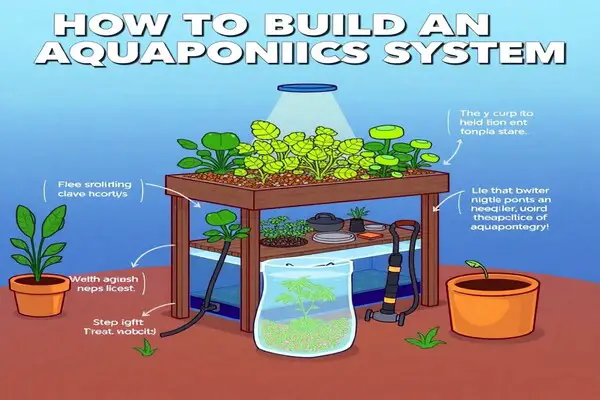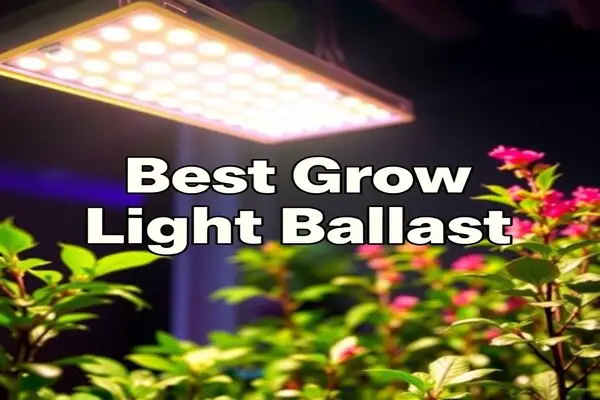Are you fascinated by the idea of growing your own food but lack the space or time for a traditional garden? Look no further.
An aquaponics system might be the perfect solution for you. This innovative method combines aquaculture and hydroponics, allowing you to grow plants and fish together in a symbiotic environment. Imagine having a garden that uses less water, requires minimal maintenance, and produces healthy, organic vegetables. That’s the promise of aquaponics. Whether you’re a beginner or an experienced gardener, building an aquaponics system is simpler than you might think. With step-by-step guidance, you can set up your own system and enjoy fresh produce year-round. Ready to dive in? Check out Aquaponics 4 You™ for detailed instructions and more information on how to get started. Learn more about Aquaponics 4 You™ and start your journey to efficient, sustainable gardening today. So without further delay lets jump in to the detail about How to Build an Aquaponics System Step by Step Guide
Introduction To Aquaponics Systems
Welcome to the world of aquaponics! This innovative method of gardening combines aquaculture and hydroponics to create a symbiotic environment. An aquaponics system allows you to grow plants and fish together in a single, integrated system. This method is highly efficient, eco-friendly, and produces nutrient-rich, organic vegetables.
What Is Aquaponics?
Aquaponics is a sustainable farming method that merges aquaculture (raising fish) and hydroponics (growing plants without soil). In this system, fish waste provides organic nutrients for plant growth. In return, plants filter and clean the water, creating a balanced ecosystem.
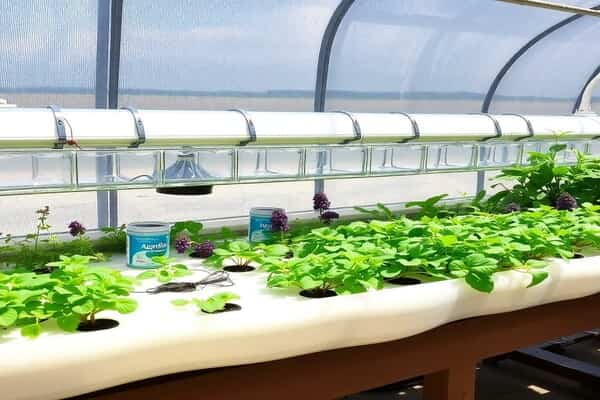
- High Yield: Grow up to ten times more plants in the same space.
- Faster Growth: Plants grow 50-100% faster than traditional methods.
- Low Maintenance: Automated system reduces the need for weeding and fertilizing.
Benefits Of Aquaponics
Aquaponics offers numerous benefits compared to traditional gardening methods. Here are some key advantages:
| Benefit | Details |
|---|---|
| Water Efficient | Uses only 2% of the water compared to traditional gardening. |
| Energy Efficient | Uses up to 70% less energy than conventional gardening. |
| Healthier Plants | Produces nutrient-rich, organic vegetables. |
| No Soil Pests | Eliminates the need for pesticides. |
| Saves Time and Effort | Minimal daily maintenance required. |
| Economic Savings | Reduced costs on water, fertilizers, and pesticides. |
| Multiple Income Sources | Potential to sell both plants and fish. |
How Aquaponics Works
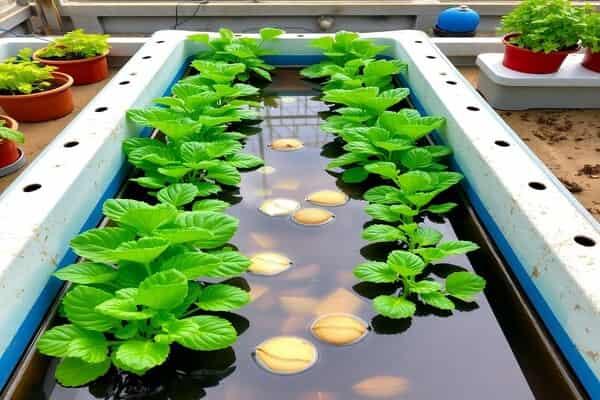
The process of aquaponics is simple yet effective. Here’s a step-by-step breakdown:
- Fish Tank: Fish produce waste in the water.
- Bacteria: Converts fish waste into nutrients for plants.
- Grow Bed: Plants absorb nutrients, filtering the water.
- Water Recirculation: Clean water is returned to the fish tank.
This cycle continues, creating a sustainable and efficient system. The result is a thriving garden that requires minimal maintenance and resources.
To get started with your own aquaponics system, consider the comprehensive guide Aquaponics 4 You™. It offers step-by-step instructions, video tutorials, and expert tips to help you succeed.
Planning Your Aquaponics System
Creating a successful aquaponics system begins with thorough planning. Proper preparation helps ensure a smooth setup and efficient operation. This section will guide you through three key areas: choosing the right location, selecting the type of system, and understanding the basic requirements.
Choosing The Right Location
The location of your aquaponics system is crucial. The ideal spot should receive at least six hours of sunlight daily. Additionally, it should be near a power source and have good access to water. Consider a space that is sheltered from harsh weather conditions to protect your system and plants.
Selecting The Type Of System
There are several types of aquaponics systems to choose from:
- Media-based systems: Use a grow bed filled with media such as gravel or clay pellets.
- Deep water culture (DWC) systems: Plants float on rafts in a nutrient-rich water bed.
- Nutrient film technique (NFT) systems: A thin film of nutrient-rich water flows over the plant roots.
Evaluate the space, budget, and specific needs of your plants and fish to select the best system for your setup.
Understanding Basic Requirements
An aquaponics system has several basic requirements for successful operation:
| Component | Description |
|---|---|
| Fish Tank | Holds the fish and provides nutrients for the plants. |
| Grow Bed | Where plants are cultivated, absorbing nutrients from the fish waste. |
| Water Pump | Circulates water between the fish tank and the grow bed. |
| Air Pump | Ensures adequate oxygen levels in the water for fish health. |
| pH Testing Kit | Maintains balanced water pH levels, ensuring optimal conditions for both fish and plants. |
Ensuring these components are in place and functioning correctly is essential for the health and productivity of your aquaponics system.
Gathering Necessary Materials And Equipment
Building an aquaponics system starts with gathering the right materials and equipment. This step ensures a smooth setup process and optimal functioning of your system. Below are key components and tools you’ll need.
Essential Components Of An Aquaponics System
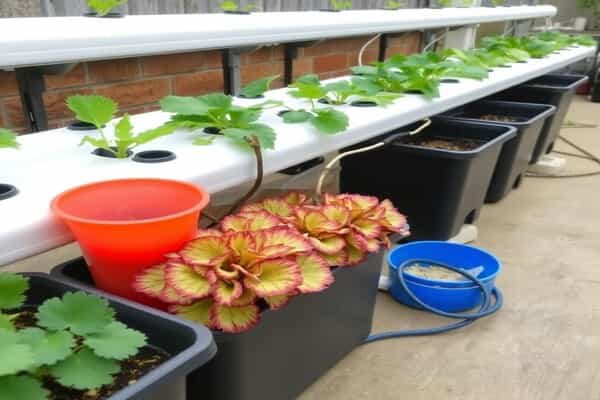
Before you start, it’s crucial to understand the main parts of an aquaponics system. These components work together to create a balanced ecosystem:
- Fish Tank: Holds the fish that provide nutrients for the plants.
- Grow Bed: Where plants grow, absorbing nutrients from the water.
- Water Pump: Circulates water between the fish tank and grow bed.
- Aeration System: Ensures sufficient oxygen levels for fish and plants.
- Plumbing: Pipes and fittings to connect the fish tank and grow bed.
- Grow Media: Supports plant roots and provides surface area for beneficial bacteria.
Tools And Materials Checklist
Having a checklist helps you stay organized. Here’s a list of tools and materials needed:
| Item | Description |
|---|---|
| Fish Tank | A container to house the fish, ideally with a capacity of 50-100 gallons. |
| Grow Bed | A shallow container for plant growth, usually made of plastic or wood. |
| Water Pump | A submersible pump to move water between the fish tank and grow bed. |
| Air Pump & Air Stones | Provides aeration for the fish tank to maintain oxygen levels. |
| PVC Pipes & Fittings | Used for plumbing to connect the fish tank and grow bed. |
| Grow Media | Gravel or clay pellets to support plant roots and bacteria. |
| pH Testing Kit | Monitors water quality to ensure a healthy environment. |
| Fish & Plants | Choose species that thrive in aquaponic systems. |
Sources For Purchasing Equipment
Finding quality materials is crucial. Here are some reliable sources:
- Local Hardware Stores: Great for basic supplies like pipes, fittings, and tools.
- Garden Centers: Ideal for grow beds, grow media, and plants.
- Online Retailers: Websites like Amazon and eBay offer a wide range of aquaponics equipment.
- Specialized Aquaponics Suppliers: Sites like Aquaponics 4 You provide comprehensive guides and specialized equipment.
Ensure you gather all necessary items before starting the assembly of your aquaponics system. This preparation will make the setup process smoother and more enjoyable.
Building The Fish Tank
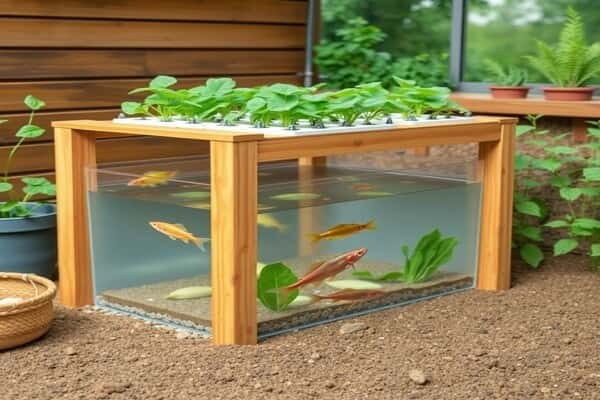
Building the fish tank is a crucial step in creating a successful aquaponics system. The fish tank serves as the home for your fish and a vital component in maintaining the balance of your ecosystem. Below are the steps to ensure your fish tank is set up correctly.
Selecting A Suitable Fish Tank
Choosing the right fish tank is essential for the health of your fish and the stability of your aquaponics system. Here are some factors to consider:
- Size: The tank should be large enough to accommodate the number of fish you plan to keep. A larger tank is more stable and requires less maintenance.
- Material: Opt for food-safe materials like glass, plastic, or fiberglass. Avoid tanks made of materials that can leach harmful chemicals into the water.
- Shape: Rectangular tanks are generally easier to work with and provide better water flow and aeration.
Setting Up The Fish Tank
Once you have selected a suitable fish tank, the next step is to set it up properly.
- Placement: Place the tank on a stable, level surface, ideally near an electrical outlet for pumps and filters.
- Cleaning: Clean the tank thoroughly with water. Avoid using soap or chemicals.
- Water: Fill the tank with dechlorinated water. Use a water conditioner if necessary.
- Filtration: Install a good quality water filter to keep the water clean and oxygenated.
Choosing And Adding Fish
Choosing the right fish is essential for a thriving aquaponics system. Consider these points:
- Species: Tilapia, goldfish, and trout are popular choices. They are hardy and adaptable to various water conditions.
- Compatibility: Ensure the fish species you select are compatible with each other and your local climate.
- Quantity: Start with a small number of fish and gradually increase. This helps the system stabilize and avoids overloading the tank.
After selecting your fish, acclimate them to the tank water to reduce stress. Float the fish in their original bag in the tank for about 20 minutes. Then, slowly introduce small amounts of tank water into the bag before releasing them into the tank.
Following these steps will help you build a robust and healthy fish tank, setting the foundation for a successful aquaponics system. however, if you want to build a pond inside an indoor or greenhouse then koi fish is also an ideal option
Constructing The Grow Bed
Building the grow bed is a crucial step in setting up your aquaponics system. This section will guide you through the process of choosing the right materials, setting up the grow bed, and selecting and planting seeds.
Choosing The Right Grow Bed Material
Choosing the right material for your grow bed is essential for durability and plant health. Here are some popular options:
- Plastic: Lightweight and easy to handle. Ensure it’s food-grade to avoid contamination.
- Wood: Natural look and sturdy. Treat it to prevent rot.
- Metal: Durable and long-lasting. Make sure it’s corrosion-resistant.
Note: Avoid materials that may leach chemicals into your water and plants.
Setting Up The Grow Bed
Once you’ve chosen your material, it’s time to set up the grow bed:
- Measure and Cut: Measure the space where you will place the grow bed. Cut the material to fit.
- Assemble: Assemble the grow bed. Ensure all joints are tight and secure.
- Install Supports: Add supports if necessary. This prevents the bed from sagging under the weight of the plants and water.
- Line the Bed: Use a pond liner or similar material to line the inside of the grow bed. This prevents leaks.
Selecting And Planting Seeds
Now that your grow bed is ready, it’s time to select and plant your seeds:
- Choose Seeds: Select seeds that thrive in aquaponic systems. Leafy greens, herbs, and some fruits are good choices.
- Pre-Germinate: Pre-germinate seeds to give them a head start. Use a wet paper towel or a seedling tray.
- Planting: Once germinated, plant the seedlings in the grow bed. Space them out to ensure they have room to grow.
By following these steps, you will have a well-constructed grow bed, ready to support your aquaponic garden. For more detailed instructions, check out the comprehensive guide at Aquaponics 4 You™.
Plumbing And Water Flow
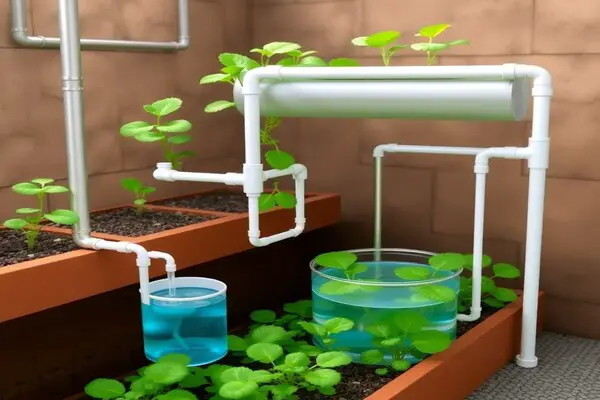
Setting up the plumbing and water flow in an aquaponics system is crucial for maintaining a healthy balance between plants and fish. Proper plumbing ensures efficient water circulation, which is vital for nutrient distribution and oxygenation. Let’s explore the key aspects of plumbing and water flow in aquaponics.
Understanding The Plumbing System
The plumbing system in an aquaponics setup consists of various components, each playing a critical role. The main elements include:
- Grow Beds: Where the plants are grown.
- Fish Tank: Home for the fish.
- Sump Tank: Collects and recirculates water.
- Pumps: Ensure continuous water movement.
- Pipes and Tubing: Connect different parts of the system.
These components work together to create a closed-loop system, allowing for the continuous flow of water and nutrients.
Setting Up Pumps And Pipes
Proper setup of pumps and pipes is essential for the smooth operation of the system. Here are the steps to follow:
- Select the Right Pump: Choose a pump that matches the size of your system. It should have enough power to circulate water between the fish tank and grow beds.
- Install the Pump: Place the pump in the sump tank or fish tank, depending on your system design.
- Connect the Pipes: Use PVC or flexible tubing to connect the pump to the grow beds and fish tank. Ensure all connections are secure and leak-free.
- Add Valves: Install valves to control the water flow between different sections of the system.
Proper installation of pumps and pipes ensures efficient water circulation, which is crucial for the health of your aquaponics system.
Ensuring Proper Water Flow
Maintaining proper water flow is essential for the health of both plants and fish. Here are some tips to ensure consistent water flow:
- Regularly Check for Blockages: Inspect pipes and filters for any debris or blockages that could hinder water flow.
- Monitor Water Levels: Ensure that water levels in the fish tank and grow beds are consistent. Adjust the flow rate if necessary.
- Use Aerators: Install aerators to increase oxygen levels in the water, benefiting both fish and plants.
- Maintain Pumps: Regularly clean and maintain pumps to prevent malfunctions and ensure optimal performance.
By following these tips, you can maintain a healthy and efficient water flow, ensuring the success of your aquaponics system.
Establishing The Nitrogen Cycle
One of the most critical steps in building an aquaponics system is establishing the nitrogen cycle. This process is essential for creating a balanced ecosystem where fish and plants can thrive. Understanding and maintaining this cycle ensures healthy plant growth and a stable environment for the fish.
Importance Of The Nitrogen Cycle
The nitrogen cycle is fundamental for converting fish waste into nutrients that plants can use. In an aquaponic system, fish produce waste that contains ammonia. Ammonia is toxic to fish, but beneficial bacteria convert it into nitrite and then into nitrate. Plants absorb these nitrates as nutrients, helping them grow faster and healthier.
Without a properly established nitrogen cycle, ammonia levels can rise, causing harm to the fish. This cycle ensures a symbiotic relationship between fish and plants, promoting a sustainable and efficient system.
Steps To Establish The Nitrogen Cycle
- Set Up the System: Assemble your aquaponics system following the step-by-step instructions provided by Aquaponics 4 You™. Ensure all components are in place, including the fish tank, grow beds, and water pumps.
- Add Water: Fill the fish tank with water. Dechlorinate the water if necessary, as chlorine can harm beneficial bacteria.
- Introduce Ammonia: Add a small amount of ammonia to the system. This can be done using fish food, pure ammonia, or fish waste.
- Monitor Ammonia Levels: Use a test kit to check ammonia levels daily. Initially, levels will rise, providing food for the bacteria.
- Wait for Bacterial Colonization: Allow time for beneficial bacteria to develop. This can take 4-6 weeks. During this period, ammonia levels will drop as bacteria convert it to nitrite, then nitrate.
- Introduce Plants: Once nitrate levels are detectable and ammonia and nitrite levels are low, add plants to the grow beds. They will start absorbing the nitrates.
Monitoring And Maintaining The Cycle
Regular monitoring is essential to maintain a balanced nitrogen cycle. Use test kits to check ammonia, nitrite, and nitrate levels weekly. Ensure ammonia and nitrite levels remain low while nitrate levels stay within a suitable range for plant growth.
Keep an eye on the health of your fish and plants. Healthy fish and vigorous plant growth indicate a well-maintained nitrogen cycle. Make adjustments as necessary, such as adding more plants or adjusting feeding amounts, to keep the system balanced.
Maintain a clean system by regularly removing excess waste and debris. This helps prevent the buildup of harmful substances and supports the beneficial bacteria.
Maintaining Your Aquaponics System
Maintaining your aquaponics system is crucial for ensuring healthy fish and thriving plants. Regular checks and timely interventions can keep your system running smoothly. Below, we will discuss daily and weekly maintenance tasks, troubleshoot common issues, and offer tips for keeping your fish and plants healthy.
Daily And Weekly Maintenance Tasks
Regular maintenance tasks are essential to ensure your aquaponics system functions well. Here are some daily and weekly tasks to consider:
- Daily Tasks:
- Check the water temperature to ensure it is within the optimal range for your fish and plants.
- Inspect the water level in the fish tank and top up if necessary.
- Feed the fish the appropriate amount of food to avoid overfeeding.
- Observe the fish for any signs of stress or disease.
- Weekly Tasks:
- Test the water quality parameters, including pH, ammonia, nitrite, and nitrate levels.
- Clean the filters and remove any debris that may clog the system.
- Trim any overgrown plants to ensure they do not block light for other plants.
- Inspect the plumbing and pumps for any signs of wear or leaks.
Troubleshooting Common Issues
Even with regular maintenance, you might encounter some common issues in your aquaponics system. Here are a few problems and their solutions:
| Issue | Solution |
|---|---|
| High Ammonia Levels | Reduce feeding and check the filtration system. |
| Algae Growth | Reduce light exposure and ensure proper water circulation. |
| Fish Stress | Check water quality and ensure adequate oxygen levels. |
| Plant Yellowing | Check nutrient levels and adjust pH if necessary. |
Tips For Healthy Fish And Plants
Maintaining a healthy balance in your aquaponics system is key to success. Here are some tips to ensure your fish and plants thrive:
- Choose Compatible Species: Select fish and plants that thrive in similar water conditions.
- Monitor Water Quality: Regularly test water parameters to prevent toxic build-up.
- Provide Proper Nutrition: Use high-quality fish food and consider supplements if necessary.
- Ensure Adequate Light: Provide sufficient light for plant growth, but avoid excessive light to prevent algae.
- Maintain System Cleanliness: Clean filters and remove debris to keep water flow unobstructed.
Following these guidelines will help you maintain a productive and healthy aquaponics system.
Harvesting And Utilizing Your Produce
Growing your own food with Aquaponics 4 You™ is an enriching experience. After setting up your system, it’s time to reap the rewards. This section guides you on how to harvest and use your produce effectively.
When And How To Harvest Fish
Harvesting fish from your aquaponics system requires careful timing and methods. Follow these steps for a successful fish harvest:
- Monitor Growth: Track the growth of your fish. Most fish reach harvest size in 6-12 months.
- Check Species-Specific Signs: Different fish species show distinct signs when they are ready for harvest. Research your specific fish type.
- Use Proper Tools: Use nets or buckets to catch the fish. Avoid stressing them.
- Follow Health Guidelines: Ensure the fish are healthy and free from diseases before harvesting.
Harvesting fish at the right time ensures a continuous supply and maintains the balance of your aquaponic system.
Harvesting Vegetables And Herbs
Vegetables and herbs grown in an aquaponic system tend to mature faster. Here’s how to harvest them properly:
- Identify Maturity: Different plants have different maturity signs. Leafy greens like lettuce can be harvested when they reach a desirable size.
- Use Clean Tools: Use clean scissors or knives to cut vegetables. This prevents infection.
- Harvest Regularly: Regular harvesting encourages new growth. It also prevents overcrowding.
- Handle with Care: Handle the produce gently to avoid bruising and damage.
Regular harvesting keeps your plants healthy and productive.
Utilizing Your Harvest
Once harvested, you can use your produce in various ways:
- Cooking: Use fresh vegetables and herbs in your daily meals. They are organic and nutrient-rich.
- Preserving: You can preserve your harvest by freezing, drying, or canning. This ensures you have a supply during off-seasons.
- Selling: Consider selling excess produce. This can be an additional source of income.
- Composting: Use any waste parts to create compost. This can further enrich your aquaponic system.
Utilizing your produce effectively adds value to your aquaponic system and promotes sustainable living.
Conclusion And Additional Resources
Building an aquaponics system can be rewarding and efficient. You can enjoy fresh, organic vegetables and fish while saving time and resources. Let’s summarize the key steps and explore further learning opportunities to ensure your success.
Summary Of Key Steps
- Plan Your System: Decide the size and location of your aquaponics setup.
- Select Your Components: Choose the right fish tank, grow beds, and pumps.
- Set Up the System: Assemble the components and establish the water flow.
- Cycle the System: Introduce beneficial bacteria to balance the ecosystem.
- Add Fish and Plants: Introduce fish and plant seeds or seedlings.
- Monitor and Maintain: Regularly check water quality, feed fish, and maintain the system.
Additional Learning Resources
To expand your knowledge and skills, explore the following resources:
| Resource | Description |
|---|---|
| Aquaponics 4 You™ | A comprehensive guide with video instructions and eBook for building and maintaining an aquaponic system. |
| Organic Gardening for Beginners | Learn the basics of organic gardening to enhance your aquaponics setup. |
| Herbs for Health and Home | Guide on using herbs for cleaning and pest control, adding value to your garden. |
| A Guide to Flower Gardening | Tips and secrets for successful flower gardening. |
| Worm Farming – The World Best Compost | Guide on worm farming for compost, improving soil health. |
| Guide to Organic Cooking | Learn to cook with organic ingredients from your garden. |
| Eating Healthy | Tips on healthy eating to look younger and feel fantastic. |
Inspiration From Successful Aquaponics Systems
Here are some inspiring examples of successful aquaponics systems:
- Home-Based Systems: Many individuals have transformed their backyards into productive aquaponic gardens, producing fresh vegetables and fish year-round.
- Community Projects: Schools and community centers have implemented aquaponics systems, providing education and fresh produce to their communities.
- Commercial Farms: Some businesses have scaled up aquaponics to commercial levels, supplying local markets with organic produce and fish.
By following these steps and utilizing the resources provided, you can build a successful and efficient aquaponics system. Happy gardening!
Frequently Asked Questions
What Is An Aquaponics System?
An aquaponics system combines aquaculture and hydroponics, using fish waste to nourish plants. It creates a self-sustaining environment.
How Does Aquaponics Work?
Aquaponics works by circulating water between fish tanks and plant beds. Fish produce waste, which plants absorb as nutrients, cleaning the water.
What Are The Benefits Of Aquaponics?
Aquaponics saves water, grows plants faster, and produces both fish and vegetables. It is eco-friendly and space-efficient.
What Do You Need For Aquaponics?
You need a fish tank, grow beds, a water pump, and plants. Fish and bacteria are also essential for nutrient cycling.
Conclusion
Building an aquaponics system can be rewarding. Follow the steps carefully. Enjoy fresh produce and healthy fish year-round. Aquaponics 4 You™ offers an excellent guide. It simplifies the process with easy instructions. Check out Aquaponics 4 You™ here to start your journey. With the right guidance, your setup will thrive. Happy gardening!

